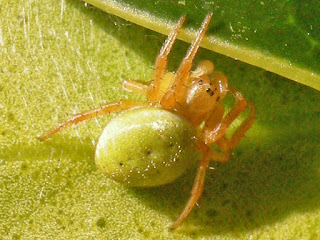- Friday 25th: 2 Common Flat-bodies Agonopterix heracliana, March Moth, Common Quaker, 9 Hebrew Characters and 3 Early Greys;
- Saturday 26th: March Moth, Dotted Border and 4 Hebrew Characters;
- Easter Sunday 27th: just Small Quaker and 3 Hebrew Characters;
- Monday 28th: 3 Small Quakers, Clouded Drab, 7 Hebrew Characters and Chestnut;
- Tuesday 29th: 3 Hebrew Characters and Early Grey;
- Wednesday 30th: March Moth, 4 Small Quakers, Common Quaker, 8 Hebrew Characters and Early Grey;
- Thursday 31st: just 6 Hebrew Characters.
Clouded Drab, North Elmham, 28th March
Things started warming up a bit in April. Highlight on 1st was another Tufted Button Acleris cristana - my third this year and third ever. All 3 have been very differently marked individuals. I thought this one was going to be hastiana as the tufts weren't very large, but not sure these markings are found on hastiana (at least I haven't come across any photos showing these markings). I checked its genitalia just to be sure and it was indeed cristana
Tufted Button Acleris cristana (male, gen det), North Elmham, 1st April
A surge in Clouded Drabs was a surprise as it's not been a great year for them so far, though they didn't quite outnumber what's currently by far the commonest moth here: Hebrew Character. The night's totals were Common Flat-body Agonopterix heracliana, March Moth, Shoulder Stripe, 8 Clouded Drabs, 9 Hebrew Characters and Chestnut.
I've described the avian highlights of a visit to Sculthorpe Moor in my birding diary but there were plenty of non-avian delights too. A Bank Vole made a few brief appearances at Woodland Hide and along the dyke was a host of spawning frogs. I did a quick count and totalled 80 Common Frogs, but as many weren't in view for a lot of the time I should imagine the real number must have been well into triple figures.
Bank Vole, Sculthorpe Moor, 2nd April
Common Frogs, Sculthorpe Moor, 2nd April
Nearby and on the boardwalk was a lone Common Toad and beside it were several Scarlet Elfcup fungi - looking much larger than I'd seen them before, presumably just because they were later in development and more opened-out (at least I'm assuming it was Scarlet Elfcup - please correct me if I'm wrong).
Scarlet Elfcups, Sculthorpe Moor, 2nd April
A Peacock butterfly took advantage of the sunshine and a small insect along the river caught my attention as it flew across the path and landed on the fence. It was a Stonefly - not a true fly but a whole group of insects in their own right, at the same level as Dragonflies or Butterflies/Moths, but much lesser known. I've not paid much attention to them in the past and only identified one for the first time last year, in Scotland. This one was a different species, and my first of any species in Norfolk, but I'm not sure if I've been able to fully identify it. I've narrowed it down to the family Nemouridae of which there are 11 species in Britain and Ireland, and from a combination of external appearance of other individuals online and occurrence in Norfolk going on the NBN Gateway data, I think it has to be Nemoura cinerea. Not sure that's a safe ID though - online photos may not be representative and these are really best identified with reference to their genitalia (but I don't know how).
Stonefly sp., possibly Nemoura cinerea, Sculthorpe Moor, 2nd April
As we headed back to the centre 2 Stoats ran ahead of us and disappeared beneath the boardwalk just in front. We waited a bit but they didn't come out even when someone, and then we, walked over the spot where they had vanished.
This spider at Bittering is one of the Araniella species but although it resembles online images of Araniella opisthographa best, the info I can find implies that's not good enough for a firm ID.
Araniella sp., Bittering, 2nd April
Wood Anemone, Rawhall Lane, 2nd April
That evening's moth trap produced 2 Common Flat-bodies Agonopterix heracliana, 3 Shoulder Stripes, Brindled Pug, 2 Small Quakers, 3 Common Quakers, Clouded Drab, 9 Hebrew Characters and 3 Early Greys.













No comments:
Post a Comment